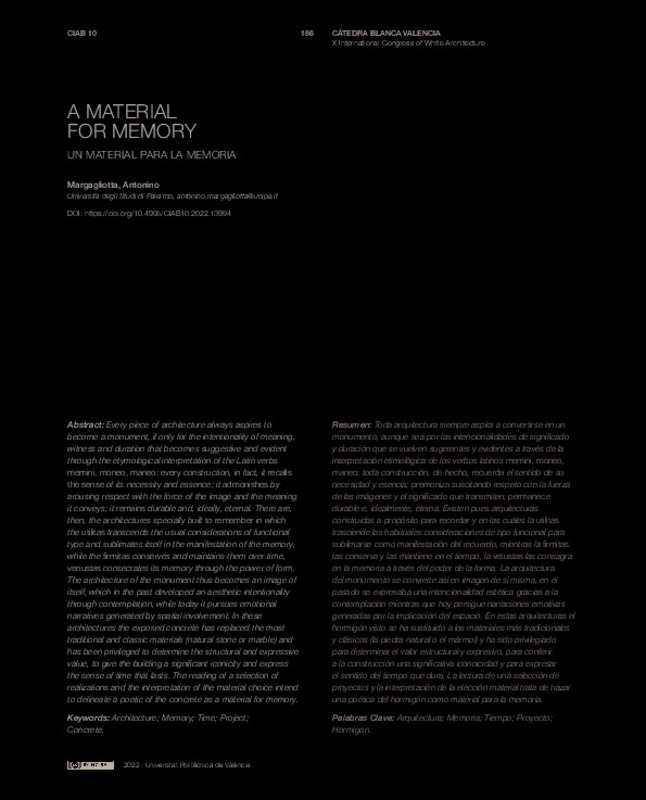JavaScript is disabled for your browser. Some features of this site may not work without it.
Buscar en RiuNet
Listar
Mi cuenta
Estadísticas
Ayuda RiuNet
Admin. UPV
Un material para la memoria
Mostrar el registro sencillo del ítem
Ficheros en el ítem
| dc.contributor.author | Margagliotta, Antonino
|
es_ES |
| dc.date.accessioned | 2022-09-14T10:44:57Z | |
| dc.date.available | 2022-09-14T10:44:57Z | |
| dc.date.issued | 2022-03-23 | |
| dc.identifier.isbn | 9788490483589 | |
| dc.identifier.uri | http://hdl.handle.net/10251/185986 | |
| dc.description.abstract | [EN] Every piece of architecture always aspires to become a monument, if only for the intentionality of meaning, witness and duration that becomes suggestive and evident through the etymological interpretation of the Latin verbs memini, moneo, maneo: every construction, in fact, it recalls the sense of its necessity and essence; it admonishes by arousing respect with the force of the image and the meaning it conveys; it remains durable and, ideally, eternal. There are, then, the architectures specially built to remember in which the utilitas transcends the usual considerations of functional type and sublimates itself in the manifestation of the memory, while the fi rmitas conserves and maintains them over time, venustas consecrates its memory through the power of form. The architecture of the monument thus becomes an image of itself, which in the past developed an aesthetic intentionality through contemplation, while today it pursues emotional narratives generated by spatial involvement. In these architectures the exposed concrete has replaced the most traditional and classic materials (natural stone or marble) and has been privileged to determine the structural and expressive value, to give the building a signifi cant iconicity and express the sense of time that lasts. The reading of a selection of realizations and the interpretation of the material choice intend to delineate a poetic of the concrete as a material for memory. | es_ES |
| dc.description.abstract | [ES] La arquitectura siempre aspira a convertirse en monumento, aunque sea por las intencionalidades de significado, testimonio y duración; la comprensión de la arquitectura como monumento se vuelve más sugestiva a través de la interpretación etimológica del término que está ligado a los verbos latinos memini, moneo, maneo: en efecto, “recuerda” el sentido de su existencia y de su esencia; “amonesta” suscitando respeto con la fuerza de la imagen y del significado que transmite; “permanece” duradero e idealmente eterno. Hay, a continuación, las arquitecturas construidas especialmente para recordar en el cual la utilitas trasciende las usuales consideraciones de tipo funcional y se sublima en la necesidad del recuerdo, mientras que quedan la firmitas (que las conserva y las mantiene en el tiempo) y la venustas que consagra el recuerdo a través del poder de la forma. La arquitectura del monumento se convierte así en imagen de sí misma que en el pasado desarrollaba una intencionalidad estética a través de la contemplabilidad, hoy a través de narraciones emocionales generadas por la implicación espacial. En la arquitectura de la memoria el hormigón visto (sustituyéndose a la piedra natural y al mármol) con su técnica se ha convertido en un material privilegiado para determinar tanto el valor estructural como el expresivo; de ser capaz, por lo tanto, dar a la construcción una significativa iconicidad y poseer (además de comunicar) el sentido del tiempo que dura. | es_ES |
| dc.format.extent | 12 | es_ES |
| dc.language | Español | es_ES |
| dc.language | Inglés | es_ES |
| dc.publisher | Editorial Universitat Politècnica de València | es_ES |
| dc.relation.ispartof | CIAB 10. X Congreso internacional arquitectura blanca | |
| dc.rights | Reconocimiento - No comercial - Compartir igual (by-nc-sa) | es_ES |
| dc.subject | Architecture | es_ES |
| dc.subject | Memory | es_ES |
| dc.subject | Project | es_ES |
| dc.subject | Essentiality | es_ES |
| dc.subject | Concrete | es_ES |
| dc.subject | Arquitectura | es_ES |
| dc.subject | Memoria | es_ES |
| dc.subject | Tiempo | es_ES |
| dc.subject | Proyecto | es_ES |
| dc.subject | Hormigón | es_ES |
| dc.subject | Time | es_ES |
| dc.title | Un material para la memoria | es_ES |
| dc.title.alternative | A material for memory | es_ES |
| dc.type | Capítulo de libro | es_ES |
| dc.type | Comunicación en congreso | es_ES |
| dc.identifier.doi | 10.4995/CIAB10.2022.13994 | |
| dc.rights.accessRights | Abierto | es_ES |
| dc.description.bibliographicCitation | Margagliotta, A. (2022). Un material para la memoria. En CIAB 10. X Congreso internacional arquitectura blanca. Editorial Universitat Politècnica de València. 186-197. https://doi.org/10.4995/CIAB10.2022.13994 | es_ES |
| dc.description.accrualMethod | OCS | es_ES |
| dc.relation.conferencename | 10º Congreso Internacional de Arquitectura Blanca - CIAB 10 | es_ES |
| dc.relation.conferencedate | Marzo 23-25, 2022 | es_ES |
| dc.relation.conferenceplace | València, España | es_ES |
| dc.relation.publisherversion | http://ocs.editorial.upv.es/index.php/CIAB/CIAB10/paper/view/13994 | es_ES |
| dc.description.upvformatpinicio | 186 | es_ES |
| dc.description.upvformatpfin | 197 | es_ES |
| dc.type.version | info:eu-repo/semantics/publishedVersion | es_ES |
| dc.relation.pasarela | OCS\13994 | es_ES |








